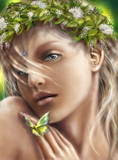
The Wiccan year is divided into 8 parts, the Quarters and the Cross Quarters.The Quarter celebrations are held at the two solstices and the two equinoxes; the longest and shortest days of the year, and the two days when night and day are equal in length.
The Cross-Quarter days are roughly midway between these days; on Feb. 2, May 1, August 1, and October 31. We call these days Sabbats, Feast Days, the Days of Festival. Since we see the wheel as round, and ever continuing, it really doesn't matter where one starts to count it; but traditionally the Wiccan year starts at Samhain, after dark on October 31.
Samhain October 31
This is the festival of the dead, Hallow-eve, when the Goddess gives the reins of government to the God. Here He presides, and the gates between the worlds are very thin. Now is the time to remember those we love who have died in the past year; for now they can join us in our celebration. The year is dying. We look forward to it's rebirth. Colors for Samhain are black, red and orange. Plants associated with it are Indian corn, pumpkins, gourds, apples and corn stalks.
Yule December 20 - 23 (winter solstice)
This is the festival of the return of Sun, when the Great Mother brings him forth new-born. The colors associated with Yule are red and green; plants are the Yule Log, mistletoe, holly, pine and pine cones, and all sorts of nuts. Traditionally, a candle (or other flame) is left burning all night on this longest of nights, to teach the new Sun how to shine.
Imbolc/ Candlemas February 2
This is the feast of the torches, also known as Bridget's Day. We bid our Lady return from the darkness, and light the flames so She may see the way. The colors of Candlemas are red and white; plants are roses, cherries, and apples.
Ostara March 20-23 (vernal equinox)
This is the festival of spring, when we welcome the Goddess back from her place of rest and ask Her blessings for new growth in the coming year. The colors of Ostara are green, white and silver; plants are all spring flowers and seeds. Colored eggs are exchanged now.
Beltane May 1
This is the May Eve, the festival of fertility, when invocations and dances are performed to ensure bountiful crops and the continued fertility of all nature (including humans!). This is the time when the God and the Goddess meet as lovers, and He gives the governing of the year to Her until Samhain. The entire rainbow is associated with Beltane, as are all flowers, garlands, trees, and fresh leaves.
Litha June 20-23 (summer solstice)
This is the festival of summer, when we dance and make merry magic in thanks for the crops growing, and the abundance of nature. This is when light is at it's peak, when the day is longest. The color of Litha is green, and plants associated with this day are roses, vines, and leaves.
Lughnassad/Lammas August 1
This is the festival of the corn, sometimes called Lammas, when the first fruits of the harvest are brought in, and in the fields the grain is ripe but not yet harvested. We rejoice in the gifts of the Great Mother. Colors for Lammas are green, yellow, and red. Plants are corn, grains, tomatoes, berries, and flowers.
Mabon September 20-23 (autumnal equinox)
This is harvest-home, when the crops have been gathered. We give thanks for the Lady's abundance, and feast on the plentiful food. The colors of Mabon are orange, brown, yellow and red. All crops are associated with this festival, as are the brilliant fall leaves.With these festivals, we celebrate the turning of the wheel, the continuance of life and the dance of the Earth around the Sun. Traditionally, the colors and plants attributed to the holiday are used in the decorations; legends that mark the turning are told, and seasonal foods are eaten. This is also the time to do magic that helps the Wheel to turn, and to take advantage of the turning to plant or harvest things in our own lives, and thank God/Goddess for the things that they have done for us.


No comments:
Post a Comment